Coupang Bundle
Who Really Owns Coupang?
Navigating the fast-paced world of e-commerce demands a clear understanding of the players involved, and Coupang SWOT Analysis can help you. Coupang, often dubbed the 'Amazon of South Korea,' has rapidly become a global force, but who truly calls the shots? Unraveling the Coupang ownership structure is key to grasping its strategic moves and future potential. This analysis dives deep into the Coupang company's ownership.
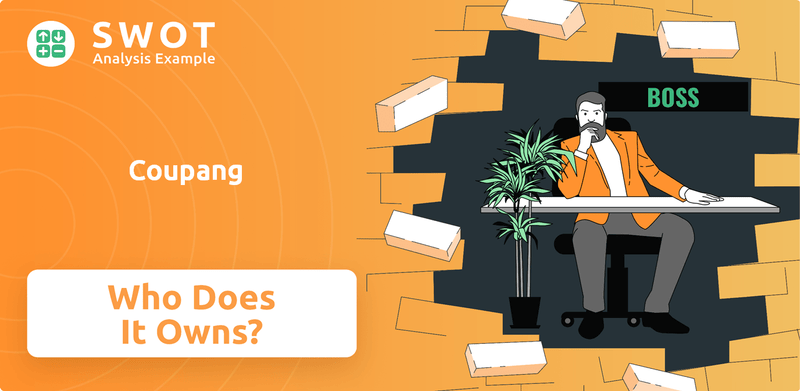
From its humble beginnings in Seoul to its current status as a Fortune 200 company, understanding who owns Coupang provides crucial insights. This exploration of Coupang's ownership will examine the influence of its founder, Bom Kim, along with the impact of key investors and public shareholders. Discover the evolution of Coupang's business, its market value, and its strategic direction, all shaped by its unique ownership dynamics. Learn about the Coupang founder and the Coupang business.
Who Founded Coupang?
The story of Coupang begins with its founder, Bom Kim, an American entrepreneur of South Korean descent. Kim launched the company in 2010, initially modeling it as a discount website similar to Groupon. This marked the beginning of what would become a significant player in the e-commerce landscape.
Bom Kim's background includes attending Harvard University and a brief stint at the Boston Consulting Group. His early ventures, such as the student magazine Current and the magazine 02138, showcased his entrepreneurial spirit before he founded Coupang. The evolution of Coupang from a discount site to a comprehensive online retailer, complete with its own logistics, highlights Kim's vision.
Understanding the Coupang ownership structure and the Coupang owner is crucial to grasping the company's trajectory. Early investments played a critical role in Coupang's growth. The company's ability to secure substantial funding allowed it to expand rapidly and establish its innovative delivery services.
Bom Kim, the Coupang founder, was born in Seoul in 1978.
He moved to the United States at age 7.
Kim attended Harvard University and briefly studied at Harvard Business School.
Kim started the student magazine Current.
He worked at Boston Consulting Group.
Kim founded the magazine 02138, raising $4 million.
Coupang launched in 2010 as a Groupon-like discount website.
It evolved into a comprehensive online retailer.
Coupang developed its own logistics service, Rocket Delivery.
Sequoia Capital was an early investor.
SoftBank was another significant early investor.
BlackRock also invested in Coupang during the initial phase.
BlackRock and Sequoia Capital invested $300 million in 2015.
SoftBank Capital and others invested $1 billion later in 2015.
These investments supported Coupang's expansion and delivery capabilities.
The funding allowed Coupang to expand its inventory.
It enabled a focus on swift deliveries.
The investments supported Coupang's disruptive e-commerce model.
The early backing from investors like Sequoia Capital, SoftBank, and BlackRock was pivotal. These investments, including a $300 million round in 2015 from BlackRock and Sequoia Capital, and a $1 billion round later that year led by SoftBank Capital, fueled Coupang's expansion. These financial infusions were critical for building out the company's inventory and its renowned fast delivery services. For a deeper dive into the business model, consider reading about the Revenue Streams & Business Model of Coupang.
Coupang SWOT Analysis
- Complete SWOT Breakdown
- Fully Customizable
- Editable in Excel & Word
- Professional Formatting
- Investor-Ready Format
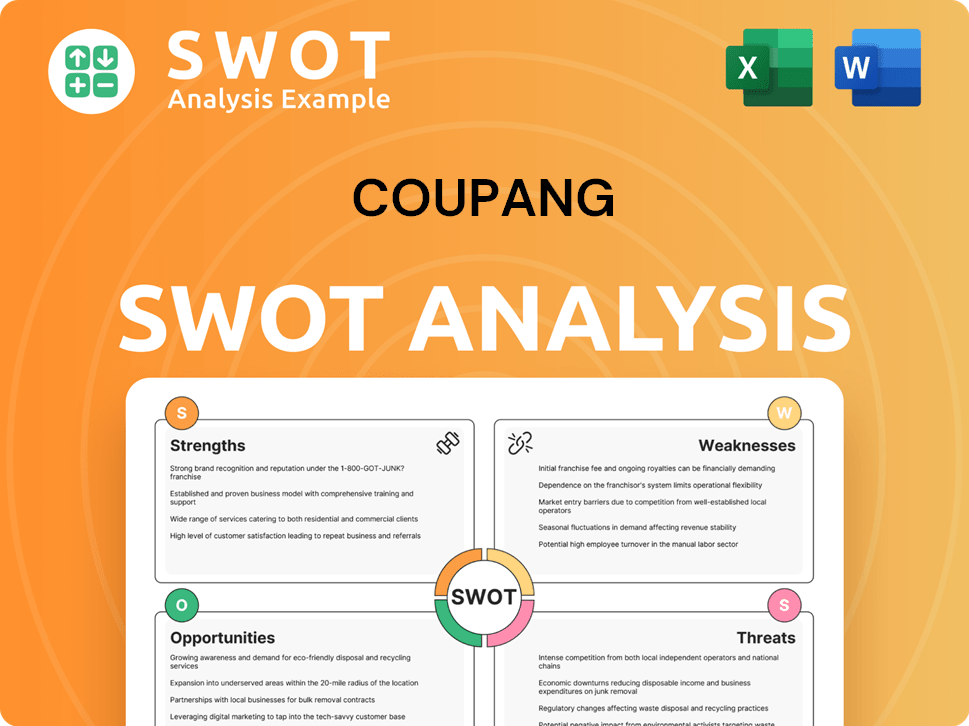
How Has Coupang’s Ownership Changed Over Time?
The evolution of Coupang ownership has been marked by significant investment rounds and its eventual initial public offering (IPO). In November 2018, the Coupang company secured a substantial $2 billion investment from SoftBank's Vision Fund, which valued the company at $9 billion. Prior to the IPO, other major investors included BlackRock and Fidelity. These investments played a crucial role in fueling Coupang's rapid expansion and market presence.
Coupang went public on the New York Stock Exchange (NYSE) on March 11, 2021, under the ticker 'CPNG'. The IPO raised $4.55 billion, the largest U.S. IPO at the time and the biggest foreign listing since Alibaba in 2014. On its first day of trading, shares closed at $49.25, giving it a market capitalization of approximately $84 billion. This IPO marked a significant milestone, transforming Coupang from a privately held entity to a publicly traded company, opening it up to a wider range of investors and increasing its visibility in the global market.
| Date | Event | Impact on Ownership |
|---|---|---|
| November 2018 | $2 Billion Investment from SoftBank Vision Fund | Valuation at $9 Billion, increased SoftBank's stake. |
| March 11, 2021 | Initial Public Offering (IPO) | Raised $4.55 Billion, increased public ownership, and introduced new institutional investors. |
| November 2024 | Shareholder Updates | SoftBank holds a significant stake of 26.7%, CEO Bom Suk Kim owns approximately 10.1%. |
As of November 2024, SoftBank remains a major shareholder, holding a 26.7% stake, while Coupang founder and CEO Bom Suk Kim owns around 10.1%. Other significant institutional shareholders include Greenoaks Capital with 16.6%, Maverick Holdings with 6.4%, and Rose Park Advisors with 5.1%. BlackRock continues to hold a 2.1% stake. Data from June 12, 2025, shows that institutional investors collectively hold 1,524,306,263 shares, representing 91.94% of the company's institutional shares. Major institutional owners include SB Investment Advisers (UK) Ltd (19.39%), Baillie Gifford & Co, Morgan Stanley, and Price T Rowe Associates Inc /md/. These shifts reflect Coupang's growth and the influence of large investment firms. Understanding the Coupang ownership structure is crucial for investors and anyone interested in the Coupang business.
Who owns Coupang? The ownership of Coupang has evolved significantly since its founding. SoftBank, the CEO, and other institutional investors are the major shareholders.
- SoftBank is a major shareholder with a significant stake.
- The IPO in 2021 brought in new investors and increased public ownership.
- Understanding the Coupang ownership structure is key for investors.
- For more insights, read about the Growth Strategy of Coupang.
Coupang PESTLE Analysis
- Covers All 6 PESTLE Categories
- No Research Needed – Save Hours of Work
- Built by Experts, Trusted by Consultants
- Instant Download, Ready to Use
- 100% Editable, Fully Customizable
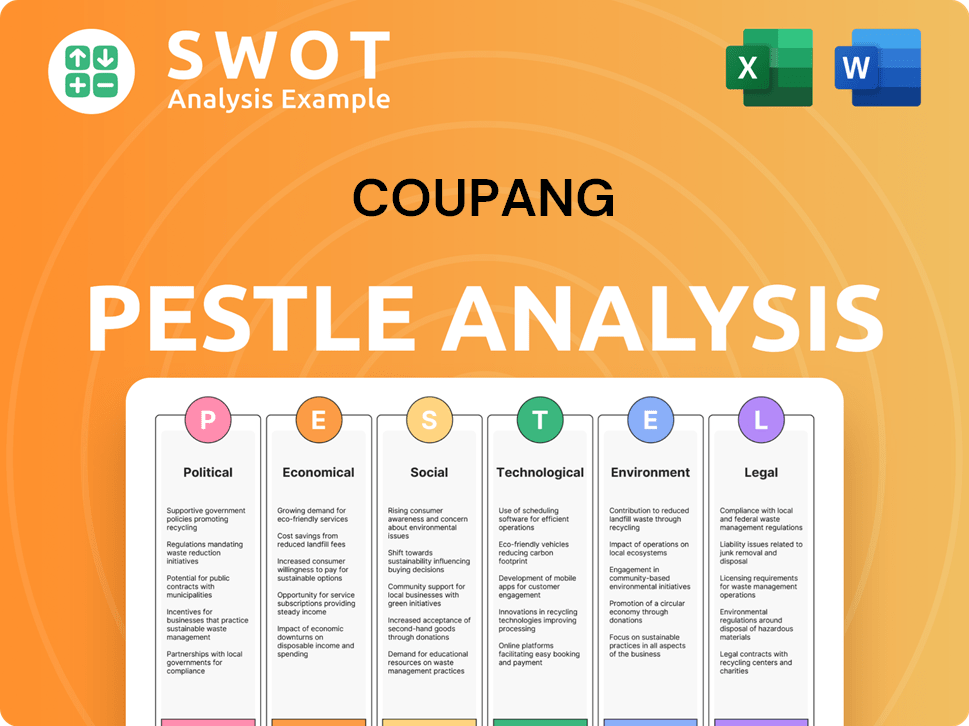
Who Sits on Coupang’s Board?
The current board of directors significantly influences the governance of the Coupang company. The board includes a mix of major shareholders, the founder, and independent members. As of June 2024, the board includes Bom Kim, the founder and CEO, who also serves as Chair, Neil Mehta (Lead Independent Director), Jason Child, Pedro Franceschi, Asha Sharma, Benjamin Sun, and Ambereen Toubassy. Asha Sharma was appointed to the Board of Directors in June 2024.
The board's composition reflects a balance of interests, with representation from key stakeholders. This structure is designed to oversee the company's strategic direction and ensure accountability. The board's decisions and oversight are critical to the company's performance and its alignment with shareholder interests. Understanding the dynamics of the board is essential for anyone interested in Coupang ownership.
| Board Member | Title | Role |
|---|---|---|
| Bom Kim | CEO and Chair | Founder |
| Neil Mehta | Lead Independent Director | Independent |
| Jason Child | Director | Independent |
| Pedro Franceschi | Director | Independent |
| Asha Sharma | Director | Independent |
| Benjamin Sun | Director | Independent |
| Ambereen Toubassy | Director | Independent |
The voting structure at Coupang features a dual-class share system that significantly concentrates voting power. As of April 14, 2025, each share of Class A common stock carries one vote, whereas each share of Class B common stock has 29 votes. This structure gives Bom Kim, the Coupang founder, considerable influence over the company's decisions, despite his individual ownership percentage. As of February 20, 2025, there were 1,647,684,518 shares of Class A common stock and 157,802,990 shares of Class B common stock outstanding. This dual-class system empowers the founder in key transactions and corporate governance matters. The annual meeting held on June 12, 2025, saw the election of directors decided by a majority vote of the outstanding common stock, with abstentions and broker non-votes counting against the proposal. There have been no recent proxy battles that significantly reshaped decision-making within the Coupang business.
The Coupang ownership structure is complex, with a dual-class share system that concentrates voting power. Bom Kim, the Coupang founder, holds significant influence. Coupang's board of directors includes a mix of major shareholders, the founder, and independent members.
- Dual-class share structure with significant voting power for Class B shares.
- Board of Directors includes founder, major shareholders, and independent members.
- The founder, Bom Kim, serves as CEO and Chair of the Board.
- Understanding the ownership is key to evaluating Coupang's strategic direction.
Coupang Business Model Canvas
- Complete 9-Block Business Model Canvas
- Effortlessly Communicate Your Business Strategy
- Investor-Ready BMC Format
- 100% Editable and Customizable
- Clear and Structured Layout
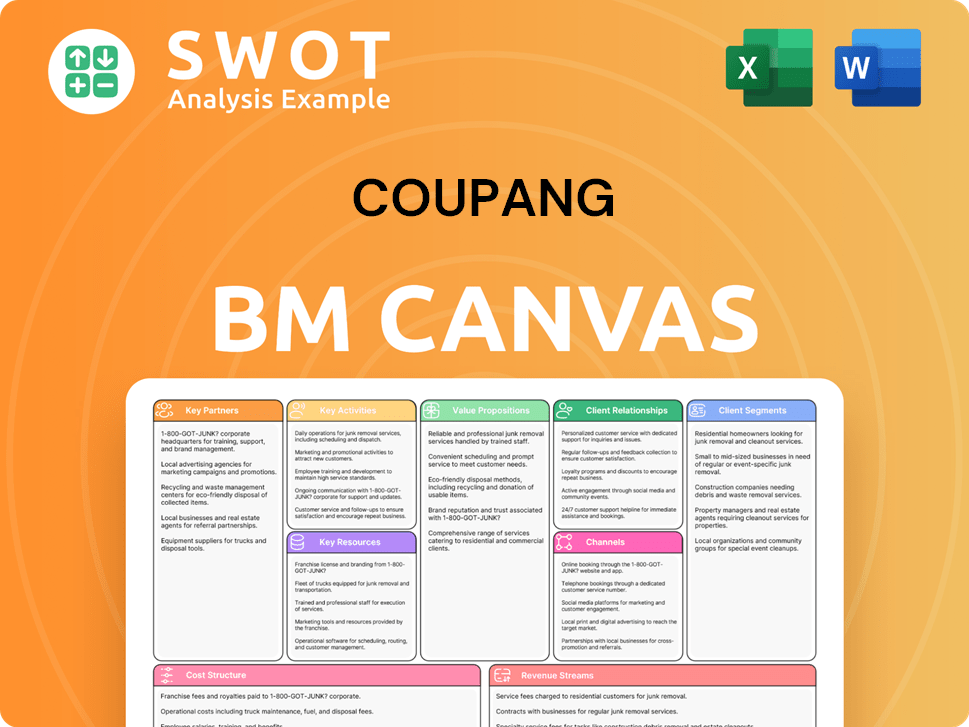
What Recent Changes Have Shaped Coupang’s Ownership Landscape?
Over the past few years, the Coupang ownership structure has seen significant shifts. A key development was the January 2024 acquisition of Farfetch, a global luxury fashion marketplace. This strategic move allowed Coupang to expand into the luxury e-commerce sector, with the deal providing Farfetch with $500 million in capital.
In November 2024, Bom Kim, the Coupang founder and CEO, initiated a pre-arranged stock trading plan. This plan allowed for the sale of up to 15,000,000 shares of Class A Common Stock, which represents less than 10% of his Class B Common Stock holdings. Following these planned transactions, Kim is expected to retain 157,802,990 shares of Class B common stock and does not plan further share transactions through the end of 2025. Additionally, Kim intends to donate up to 2,000,000 shares of Class A common stock to a fund for future charitable donations.
| Key Development | Date | Details |
|---|---|---|
| Farfetch Acquisition | January 2024 | Acquired Farfetch, a luxury fashion marketplace, for $500 million. |
| Stock Trading Plan | November 2024 | Bom Kim initiated a plan to sell up to 15,000,000 shares of Class A Common Stock. |
| Institutional Ownership | May 19, 2025 | Institutional ownership reached 83.72%. |
Institutional investors have increased their holdings in Coupang. As of May 19, 2025, institutional ownership accounts for 83.72% of the company's stock. In the fourth quarter of 2024, Ignite Planners LLC increased its holdings by 2.5%, Oak Thistle LLC acquired a new stake valued at $1,651,000, and Assenagon Asset Management S.A. grew its position by 85.4% to over 1.1 million shares. This growth indicates a strong level of confidence from institutional investors in Coupang's market position and potential for future growth. If you want to know more about the company, check out the Marketing Strategy of Coupang.
Acquisition of Farfetch in January 2024. Bom Kim's stock trading plan in November 2024. Increased institutional ownership showing confidence.
Expansion into luxury e-commerce. Founder's strategic stock management. Growing institutional investment reflects market confidence.
Increased holdings by Ignite Planners LLC. Oak Thistle LLC acquired a new stake. Assenagon Asset Management S.A. increased its position.
Continued institutional confidence. Potential for further growth. Strategic moves to expand market presence.
Coupang Porter's Five Forces Analysis
- Covers All 5 Competitive Forces in Detail
- Structured for Consultants, Students, and Founders
- 100% Editable in Microsoft Word & Excel
- Instant Digital Download – Use Immediately
- Compatible with Mac & PC – Fully Unlocked
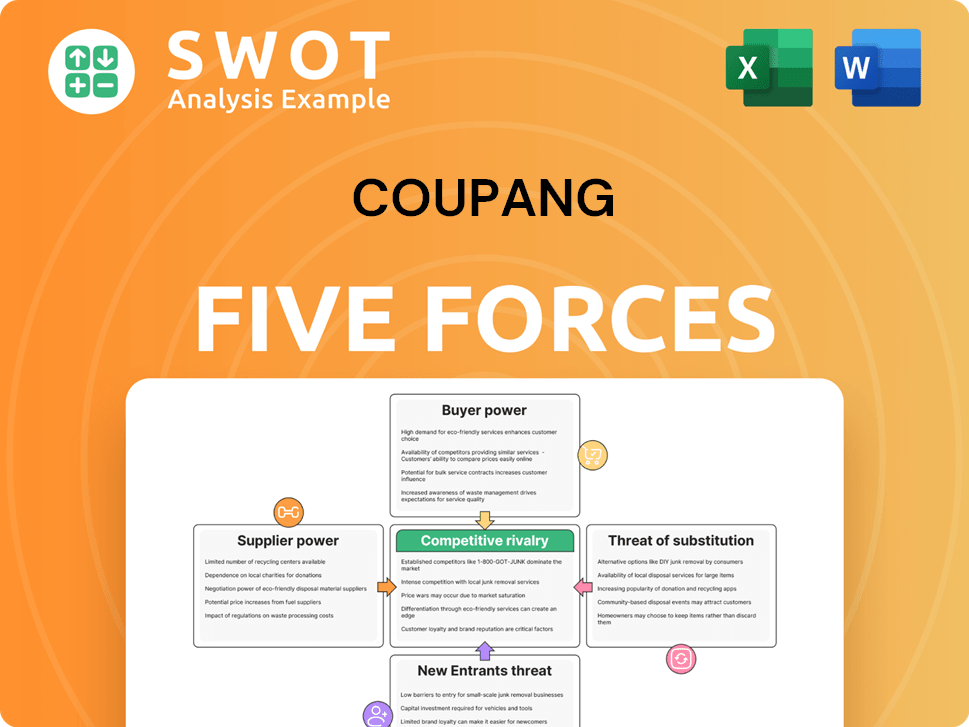
Related Blogs
- What are Mission Vision & Core Values of Coupang Company?
- What is Competitive Landscape of Coupang Company?
- What is Growth Strategy and Future Prospects of Coupang Company?
- How Does Coupang Company Work?
- What is Sales and Marketing Strategy of Coupang Company?
- What is Brief History of Coupang Company?
- What is Customer Demographics and Target Market of Coupang Company?
Disclaimer
All information, articles, and product details provided on this website are for general informational and educational purposes only. We do not claim any ownership over, nor do we intend to infringe upon, any trademarks, copyrights, logos, brand names, or other intellectual property mentioned or depicted on this site. Such intellectual property remains the property of its respective owners, and any references here are made solely for identification or informational purposes, without implying any affiliation, endorsement, or partnership.
We make no representations or warranties, express or implied, regarding the accuracy, completeness, or suitability of any content or products presented. Nothing on this website should be construed as legal, tax, investment, financial, medical, or other professional advice. In addition, no part of this site—including articles or product references—constitutes a solicitation, recommendation, endorsement, advertisement, or offer to buy or sell any securities, franchises, or other financial instruments, particularly in jurisdictions where such activity would be unlawful.
All content is of a general nature and may not address the specific circumstances of any individual or entity. It is not a substitute for professional advice or services. Any actions you take based on the information provided here are strictly at your own risk. You accept full responsibility for any decisions or outcomes arising from your use of this website and agree to release us from any liability in connection with your use of, or reliance upon, the content or products found herein.